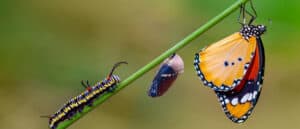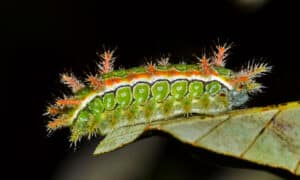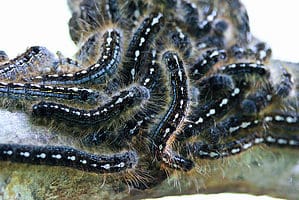Nestled within the vast expanse of New Jersey’s diverse habitats lie hidden treasures, such as the astonishing array of over 300 caterpillar species found in the state. Most live in wooded areas and gardens, but some can be found all across the Garden State. Adorned in hues that range from subtle elegance to blazing magnificence, these enchanting creatures captivate our senses. Step into the captivating realm of New Jersey’s caterpillars, a world brimming with intriguing facts and mesmerizing behavioral patterns.
The Classification of Caterpillars
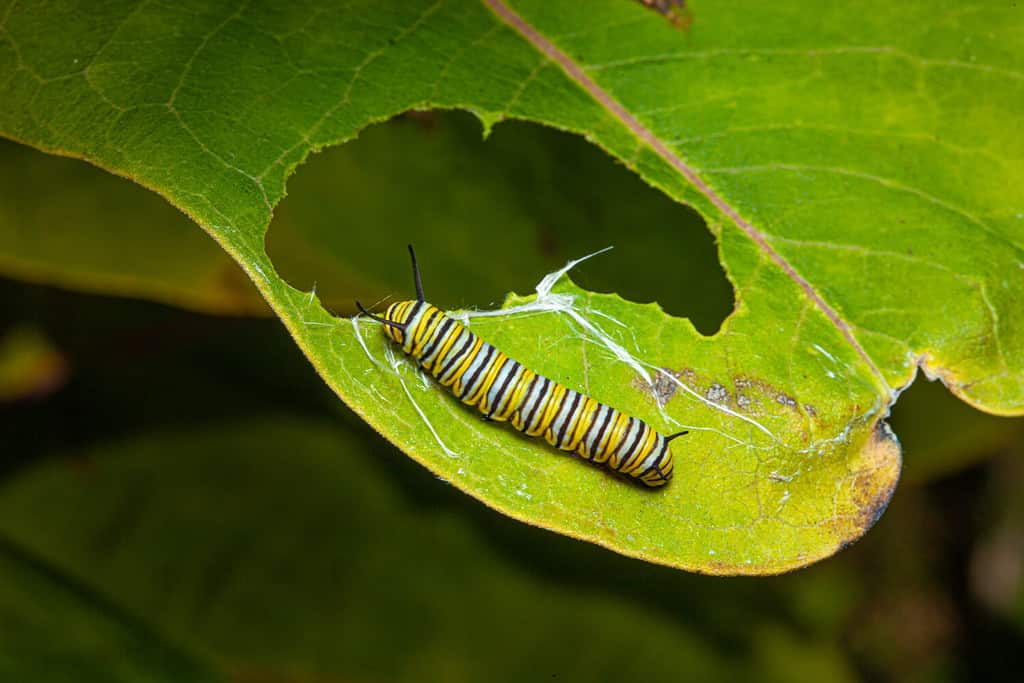
Each
caterpillar
species has its unique coloration and style.
©K Hanley CHDPhoto/Shutterstock.com
How are caterpillars in New Jersey categorized, you may wonder? Their classification is based on distinctive physical attributes, encompassing body shape, leg count, and the presence of fascinating spines. Such classification unravels invaluable insights into their remarkable biology and behavior. The intricate anatomy of caterpillars consists of three vital segments: the head, thorax, and abdomen, each fulfilling a unique role. Furthermore, their complexity is further enhanced by distinctive leg arrangements and a repertoire of defense mechanisms, including protective spines. As for their behaviors, they elicit a fascinating range, with some leading solitary lives, while others prefer to exhibit their activities during the day or the night.
Is It a Moth Caterpillar or a Butterfly Caterpillar?
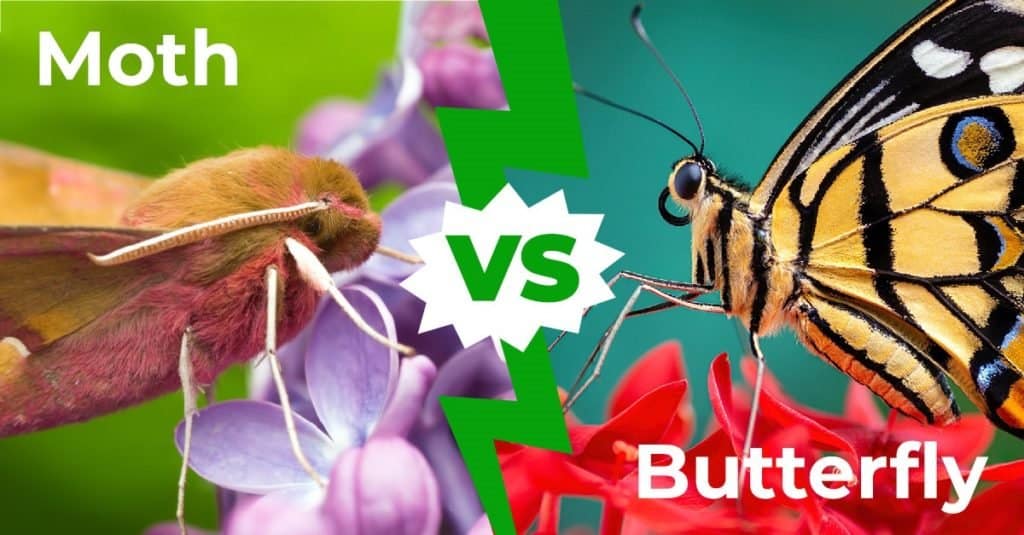
While they have similarities, there are notable differences between moths and butterflies. Starting with antennae, butterflies have club-shaped ones, while moths have feathery or saw-edged ones. In terms of wings, butterflies fold them vertically over their backs at rest, while moths fold them horizontally or in a tent-like manner. Butterflies are diurnal, and active during the day, while moths are primarily nocturnal. However, there are exceptions, like crepuscular butterflies at dawn and dusk, and diurnal moths like the captivating hummingbird moth. Butterflies use vibrant colors to attract mates and deter predators. Moths often display more subdued colors. Butterflies inhabit diverse environments, from forests to meadows and gardens. Moths prefer dark and sheltered places like caves and forests.
Moth Caterpillars Found in New Jersey
Let’s get into some of the moth caterpillars that you might cross paths with in New Jersey!
1. Cecropia Moth Caterpillar (Hyalophora cecropia)
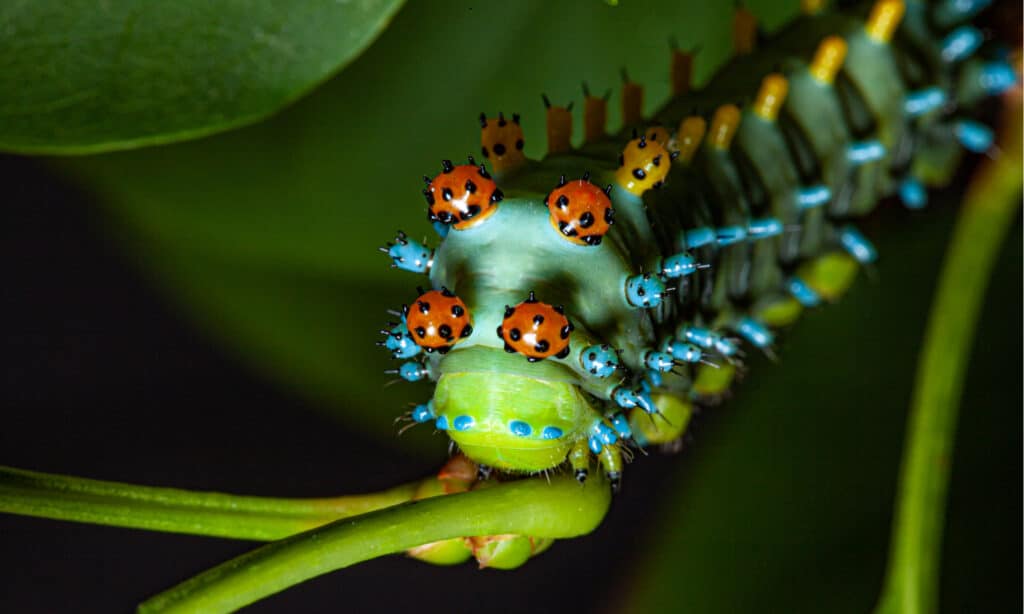
The cecropia moth caterpillar’s unique characteristics serve as a natural defense against potential predators.
©K Hanley CHDPhoto/Shutterstock.com
The cecropia moth caterpillar is the larval stage of the cecropia moth and is one of the largest indigenous moths in North America. With a length of approximately 4 inches, it displays a vibrant greenish-blue body adorned with red, yellow, and blue spiny tubercles. The caterpillar’s notable appearance and spiny exterior act as warning signals to ward off any threats, with its spines being promptly raised in defense when provoked. Feeding on a variety of trees and shrubs, the caterpillar undergoes five larval instars (stages), with each stage spanning about a week. Upon reaching the fifth instar, the caterpillar diligently constructs a silk cocoon and proceeds through the pupa stage. Come spring, the cecropia moth emerges from its pupal form to fulfill its role as a dedicated pollinator.
2. Luna Moth Caterpillar (Actias luna)
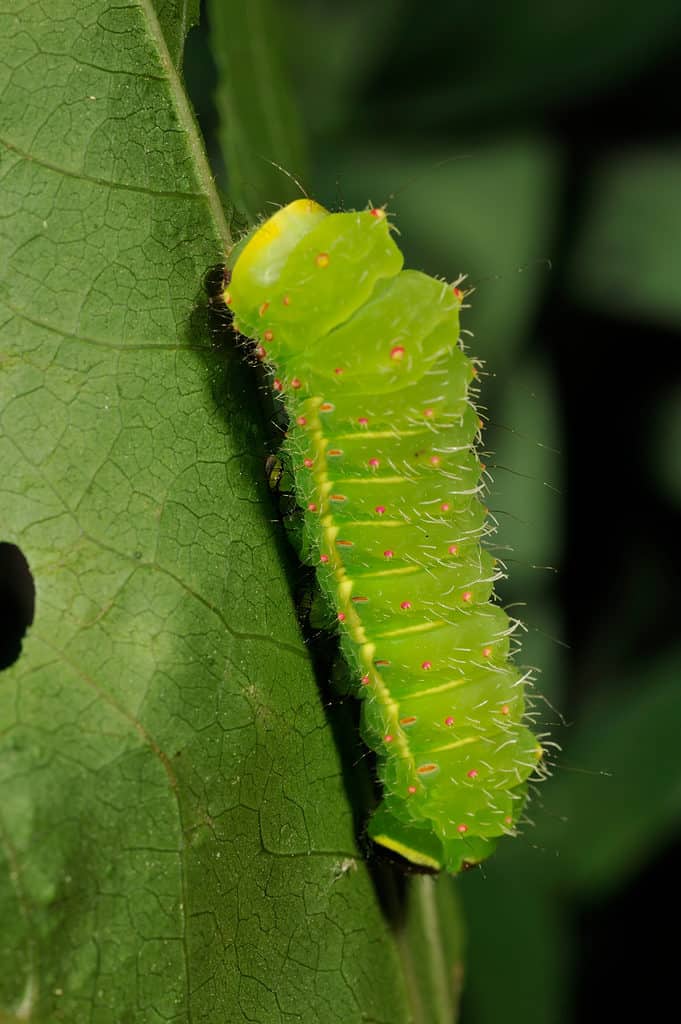
The
luna moth
caterpillar is a stunning green creature in New Jersey.
©Breck P. Kent/Shutterstock.com
The luna moth caterpillar is an extraordinary creature in North America, from southern Canada to Mexico. It reaches a length of 2 to 2.5 inches, with an elegant body adorned with charming orange spots. Its velvety texture comes from delicate hair covering its entire body. Feeding voraciously on leaves of walnut, hickory, sweetgum, and paper birch trees, it consumes a remarkable amount in a short time. After weeks of feasting, it encases itself in a silky cocoon for about a month, before transforming into a resplendent adult moth in just three weeks. The adult moth flaunts lime-green wings with intricate patterns of dark spots and lines.
3. Polyphemus Moth Caterpillar (Antheraea polyphemus)
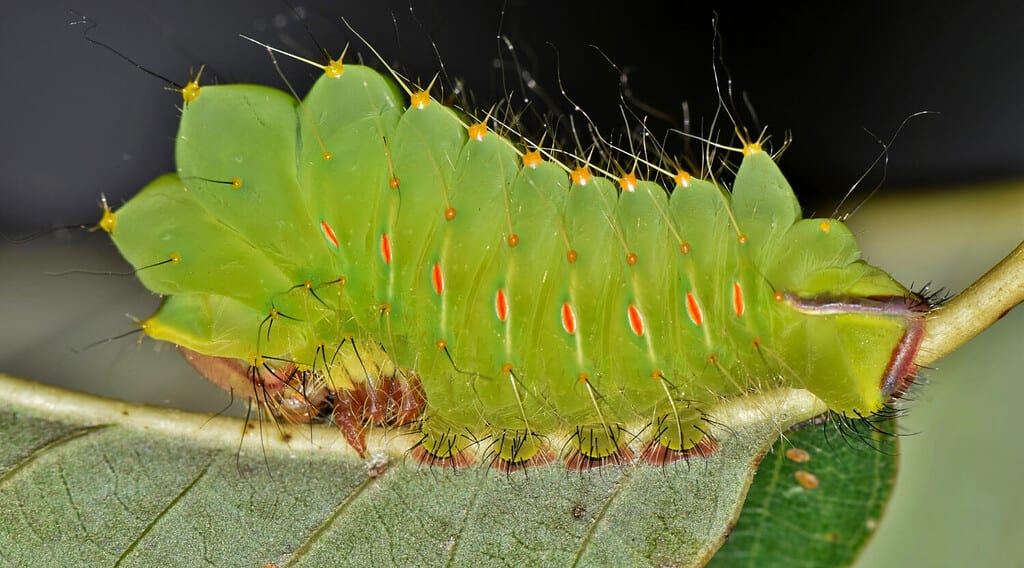
The Polyphemus moth caterpillar’s vibrant color is a warning to predators, and the eyespots create the illusion of a larger creature when the caterpillar raises its body.
©Brett Hondow/Shutterstock.com
The Polyphemus moth caterpillar grows to about 4 inches long. It has a smooth body with raised bumps on its back. The yellow eyespots with black borders and a black pupil are found in segments 10 and 11. Feeding on leaves of trees like oak, willow, maple, birch, and hickory, this caterpillar has a big appetite and eats a lot in a short time. After a month of feeding, it creates a silk cocoon and becomes a pupa. Three weeks later, it emerges as a beautiful adult moth with large wings adorned with captivating eyespots and dark spots.
4. Large Maple Spanworm Caterpillar (Prochoerodes lineola)
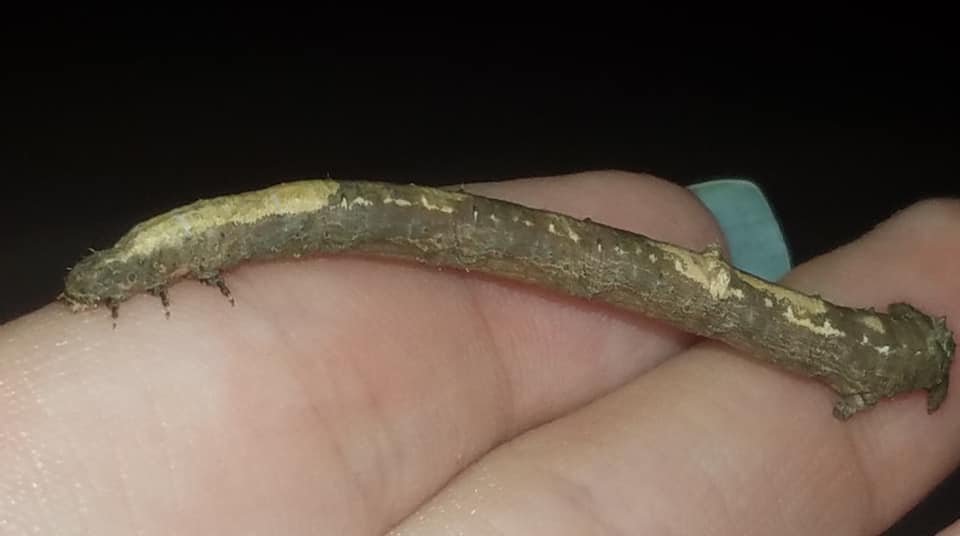
Maple spanworms have camouflage that looks like bark or a stick.
©Andy Reago & Chrissy McClarren / CC BY 2.0 – License
The large maple spanworm caterpillar can often be spotted in New Jersey in parks, gardens, and wooded areas. When fully grown, it reaches a length of approximately 1 to 1.5 inches. Adorned with a gray-brown body, distinctive black spots, and a bark-like pattern, it presents a humble yet captivating appearance. Remarkably harmless, this enchanting creature does not possess the ability to sting. The large maple spanworm caterpillar has a diverse diet, indulging in oak, maple, birch, apple, and cherry trees. But its appetite doesn’t stop there — it also savors geraniums, soybeans, blueberries, and currants. Through a transformative process, the caterpillar overwinters as a pupa, only to emerge in the spring as a captivating adult moth with magnificent 1-inch brown wings.
5. Curve-lined Owlet caterpillar (Phyprosopus callitrichoides)
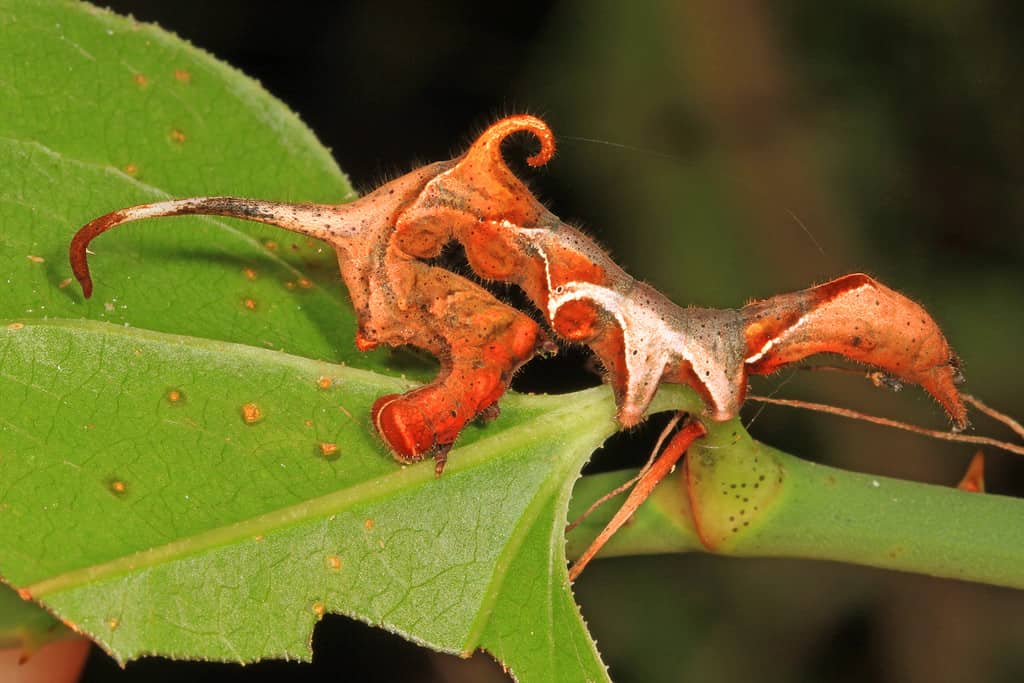
While it thrives in woodland and nearby clearings, the curve-lined owlet caterpillar is also seen in developed areas like parks and gardens.
©Judy Gallagher / CC BY 2.0 – License
The curve-lined owlet caterpillar is an intriguing creature commonly found in the eastern United States, particularly in New Jersey. Its mature size ranges from 1 to 1.5 inches in length. Adorned with a striking brown body and a distinctive white saddle-shaped marking on its back, this caterpillar also boasts two long horns or spines on its head, adding to its unique beauty. The curve-lined owlet caterpillar sustains itself by feeding on greenbrier, a widespread vine plant found in various habitats. During winter, this caterpillar transforms into a pupa, hanging gracefully by a silken thread. In the spring, an exquisite adult moth emerges from the pupa, boasting magnificent 1-inch-long brown wings.
6. Woolly Bear Caterpillar (Pyrrharctia isabella)
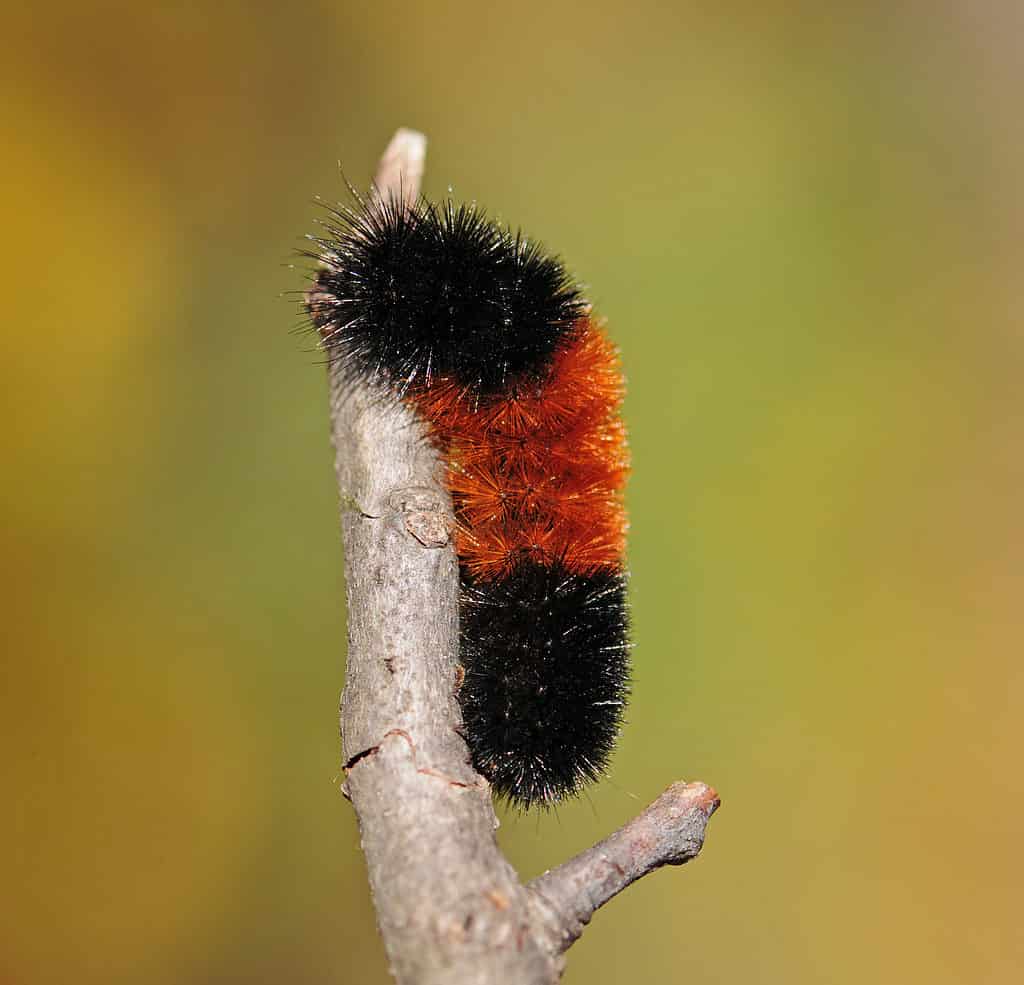
Woolly bear caterpillars are aptly named for their plush coat of hair, which aids in keeping them cozy during chilly weather.
©Nancy Bauer/Shutterstock.com
The woolly bear caterpillar represents the larval stage in the magical transformation of the Isabella tiger moth. With a wingspan of about 1 inch, adorned in captivating orange and black hues, the adult moth emerges from its pupa in the spring. Delightfully common in the picturesque landscapes of New Jersey, woolly bear caterpillars gracefully thrive in diverse habitats, embracing fields, forests, and gardens alike. In their fully grown state, they measure around 1 to 2 inches in length, boasting a striking black body graced by a reverent rusty-red band that traverses their midsection. The hue of a woolly bear caterpillar’s fur is believed to hold clues about the impending winter’s severity. A caterpillar with darker coloring is regarded as an omen of a severe winter, whereas a lighter-colored caterpillar hints at a milder winter ahead.
Butterfly Caterpillars Found in New Jersey
Caterpillars’ chosen habitats are influenced by the climate, with certain species only found in specific parts of the state, such as the mountains or coastal areas. Their habitats are also closely linked to the caterpillars’ preferred food plants. For instance, the black swallowtail caterpillar thrives on parsley, fennel, and carrot leaves, while the eastern tiger swallowtail caterpillar feasts on the foliage of tulip, elm, and ash trees. Let’s have a look at some butterfly caterpillars found in New Jersey!
7. Black Swallowtail Caterpillar (Papilio polyxenes)
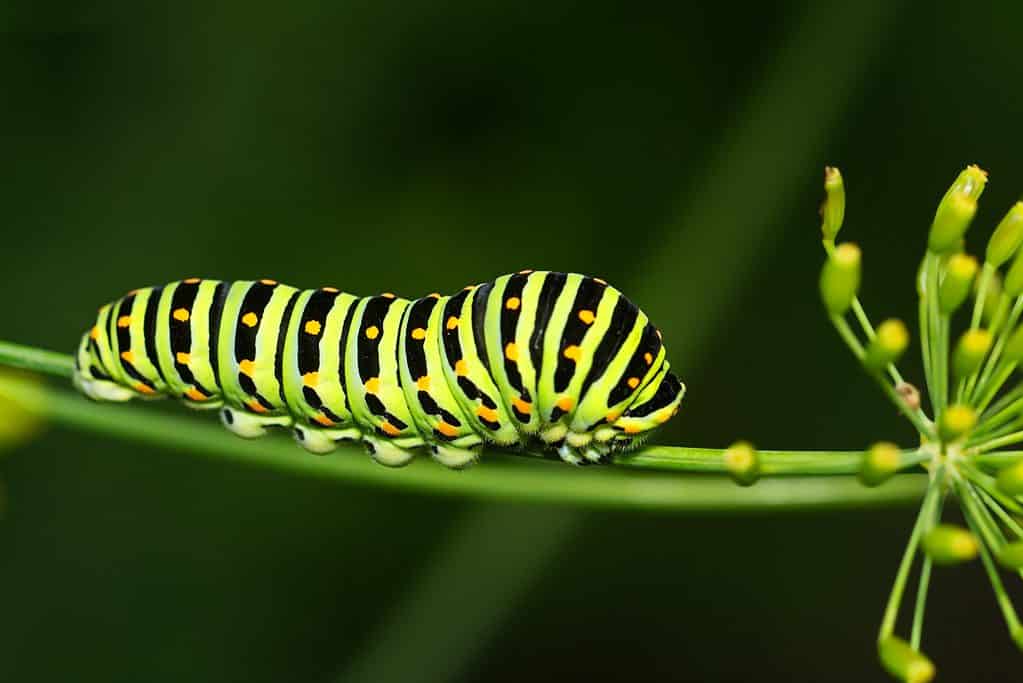
Black swallowtail butterfly caterpillars love eating plants from the carrot family.
©Graphicato/Shutterstock.com
The black swallowtail butterfly proudly holds the esteemed distinction of being New Jersey’s official state butterfly. This remarkable creature was bestowed the honor in 2015 by the state legislature and Governor Christie. With its captivating black and yellow stripes, black swallowtail butterflies gracefully adorn the skies above, leaving us in awe. As caterpillars, they devour astonishingly large amounts of the foliage of parsley, fennel, and carrot plants. These caterpillars are common in New Jersey, especially in the spring and summer.
8. Eastern Tiger Swallowtail Caterpillar (Papilio glaucus)
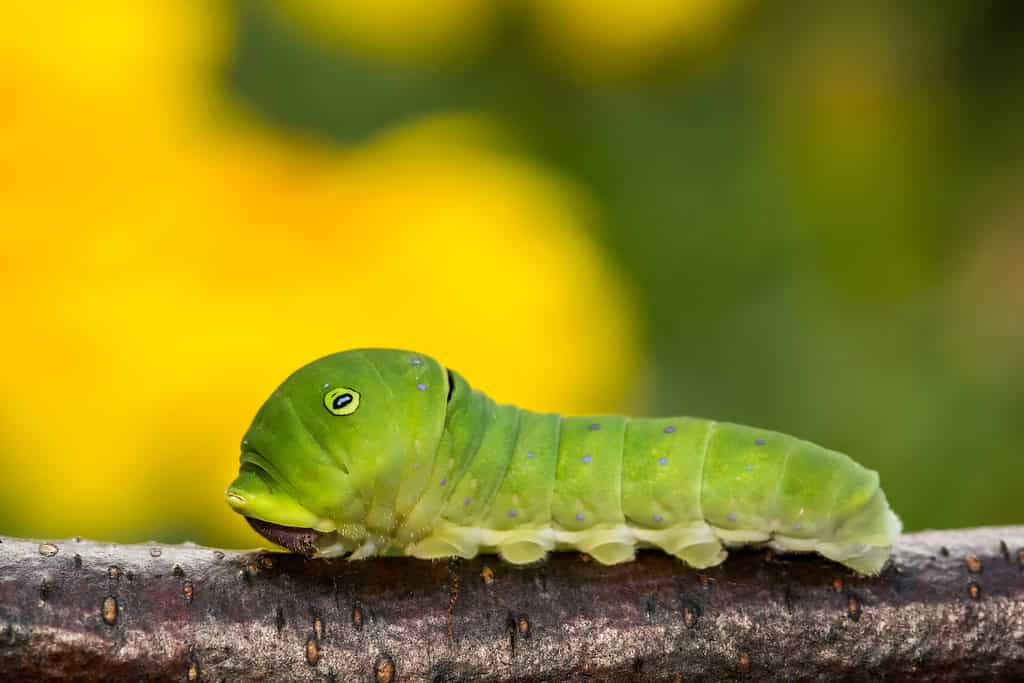
During colder months, the eastern
tiger
swallowtail butterfly enters a state of hibernation within this chrysalis, waiting patiently for the arrival of spring.
©Jay Ondreicka/Shutterstock.com
The eastern tiger swallowtail caterpillar showcases vibrant colors and intricate markings. Found in the eastern regions of North America, eastern tiger swallowtail butterflies lay their eggs on magnolia and rose plants. Caterpillars begin with a brown and white coloration, but as they mature, their bodies turn a vibrant shade of green. On their thorax, two eyespots are colored black, yellow, and blue, adding to their unique appearance. When it’s time for the caterpillar to enter the next stage of its life, it will change its color once again, becoming a rich shade of brown.
9. Spicebush Swallowtail Caterpillar (Papilio troilus)
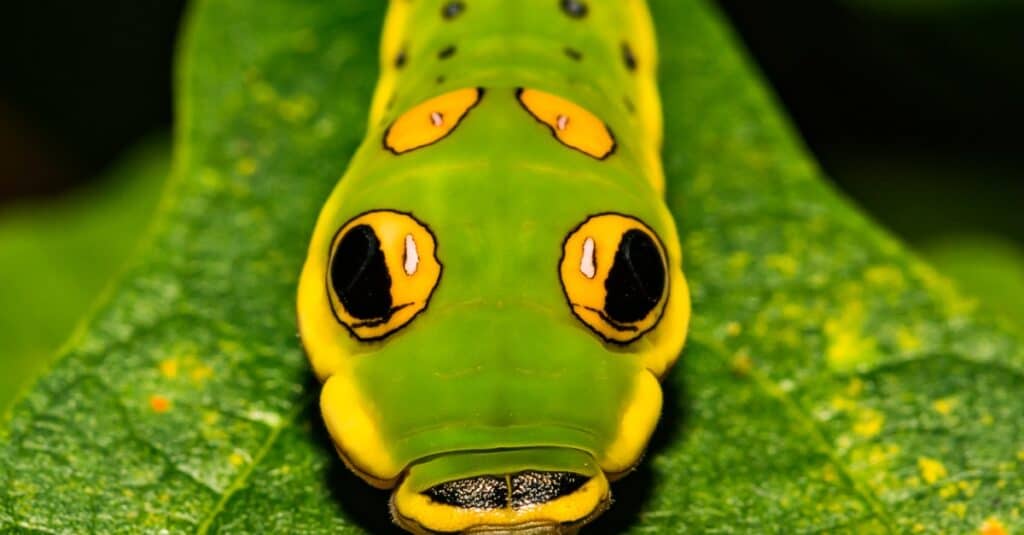
Upon reaching maturity, these caterpillars can grow up to 2 inches in length.
©iStock.com/JasonOndreicka
The caterpillar of the spicebush swallowtail displays a fascinating appearance. When they first hatch, caterpillars have a brown hue, but as they mature, their bodies transition to a green or greenish-yellow color. Their diet consists of plants belonging to the Lauraceae family, including sassafras and spicebush. After constructing cocoons, these caterpillars suspend themselves from branches or other vegetation to create pupation sites, where they will undergo transformation. Following a period of two to four weeks, the exquisite spicebush swallowtail butterfly emerges, showcasing a wingspan of 2 to 3 inches. Its wings usually possess a predominantly black coloration adorned with yellow spots. The ventral side of the butterfly typically exhibits a pale greenish-brown hue adorned with yellow and orange markings. Males possess a distinctive blue swath across the hindwing, while females lack this feature.
10. Giant Swallowtail Caterpillar (Papilio cresphontes)
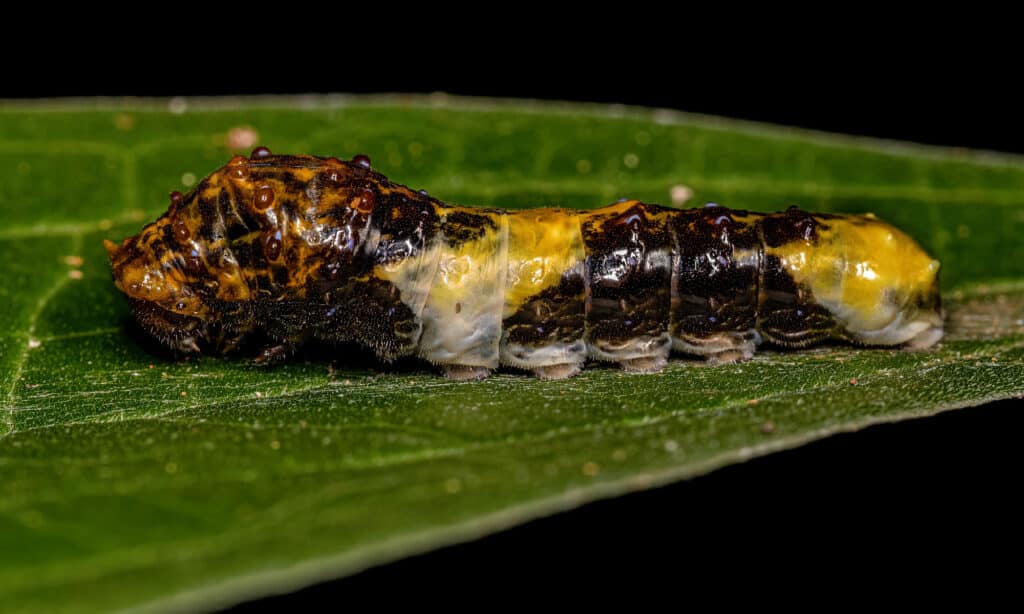
The unique appearance of giant swallowtail caterpillars is thought to be a defense mimicking bird droppings.
©iStock.com/ViniSouza128
The giant swallowtail caterpillar is one of the largest butterfly caterpillars in North America. It can grow up to 3 inches long and has a brown body with cream-colored and white patches. The caterpillar has a distinctive hump on its back and a pair of long horns on its head. After about four weeks of feeding, it enters the pupal stage by spinning a silk cocoon. In this cocoon, the pupa, measuring around 1 inch in length with a rich brown color, awaits metamorphosis into a stunning adult butterfly. This transformation takes about two weeks. Upon emerging from the pupal state, the adult giant swallowtail butterfly showcases a wingspan of approximately 6 inches.
11. Pipevine Swallowtail Caterpillar (Battus philenor)
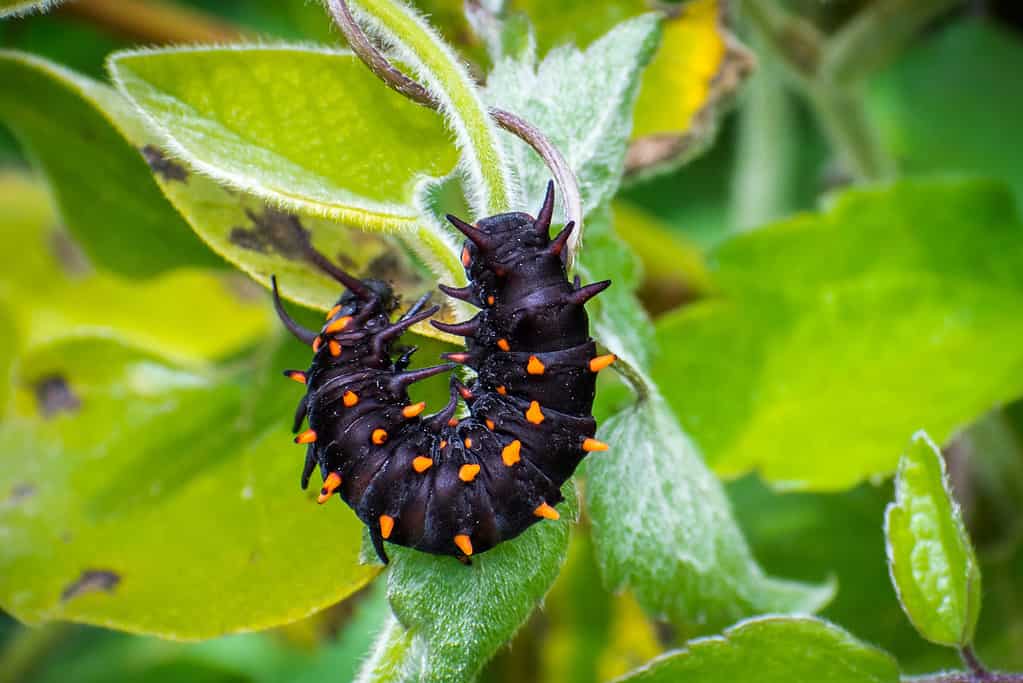
The pipevine swallowtail caterpillars don a striking appearance, adorned in deep black hues accentuated by delicate, vibrant orange spikes.
©Sundry Photography/Shutterstock.com
Lastly, the pipevine swallowtail caterpillar, a striking medium-sized beauty, flaunts a black body embellished with striking orange spikes. It elegantly feasts upon the lush leaves of the pipevine plants. Pipevine swallowtail caterpillars possess a potent defense mechanism, as they harbor toxins obtained from their plant-based diet. Their foul taste and potentially lethal consequences serve as a warning to predators who dare to prey upon them. When the pipevine swallowtail caterpillar reaches its full growth, it undergoes a remarkable transformation into a chrysalis. After a two-week metamorphosis, the adult butterfly emerges, with a captivating black and white checkered pattern adorned with vibrant blue, green, and orange markings.
Poisonous Caterpillars In New Jersey
New Jersey is a land brimming with intriguingly toxic caterpillars. Among them, the saddleback caterpillar stands out with its unique black, white, and orange patterns. Caution is paramount as its poisonous spikes inflict a painful rash upon contact. Also present is the spiny oak caterpillar, small yet armed with toxic barbs that can embed themselves in human skin or fur, causing swelling and persistent itching. These remarkable creatures fascinate with their diverse mechanisms for displaying toxicity. When unsure of a caterpillar’s toxicity, it’s prudent to exercise caution and avoid physical contact.
| Ways of Being Poisonous or Venomous | Example / Description |
|---|---|
| Toxic body | Certain caterpillars consume poisonous plants and store the toxins within their bodies. If these caterpillars are ingested, their toxins have the potential to induce illness in their predators. |
| Poisonous or venomous spines or hairs | These spines or hairs are frequently linked to glands containing venom. Upon contact, the spines or hairs detach and deliver the venom directly into the victim. |
| Poisonous liquid | Certain caterpillars have the remarkable ability to generate a toxic substance, which they release either from their mouths or their rear ends. It can cause skin irritation, intense burning sensations, and even blindness. |
12. Puss Caterpillar (Megalopyge opercularis)
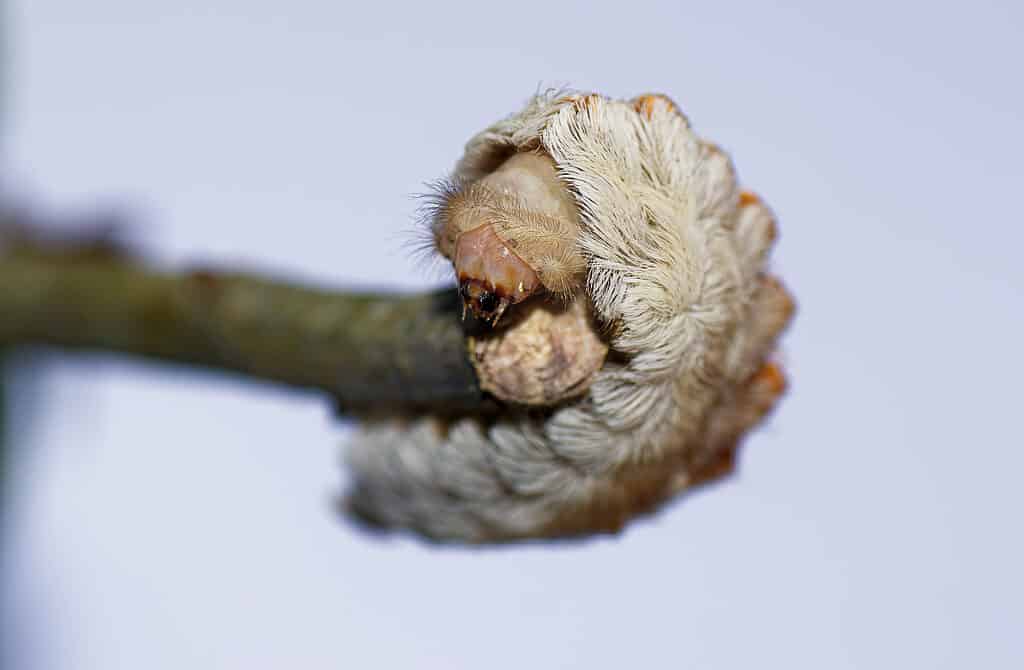
Being stung by a puss caterpillar is somewhat similar to a bee sting, but in some cases, it can also be more serious.
©Chase D’animulls/Shutterstock.com
The puss caterpillar, also known as the southern flannel moth caterpillar, is a remarkable and captivating creature. Its physical characteristics are striking, exhibiting a dense and plushy body resembling a diminutive, endearing fuzzy ball. Although its aesthetically pleasing exterior may deceive, the puss caterpillar harbors venomous spines that can cause considerable pain upon contact. Puss caterpillars live in gardens and wooded areas in New Jersey.
13. Saddleback Caterpillar (Acharia stimulea)
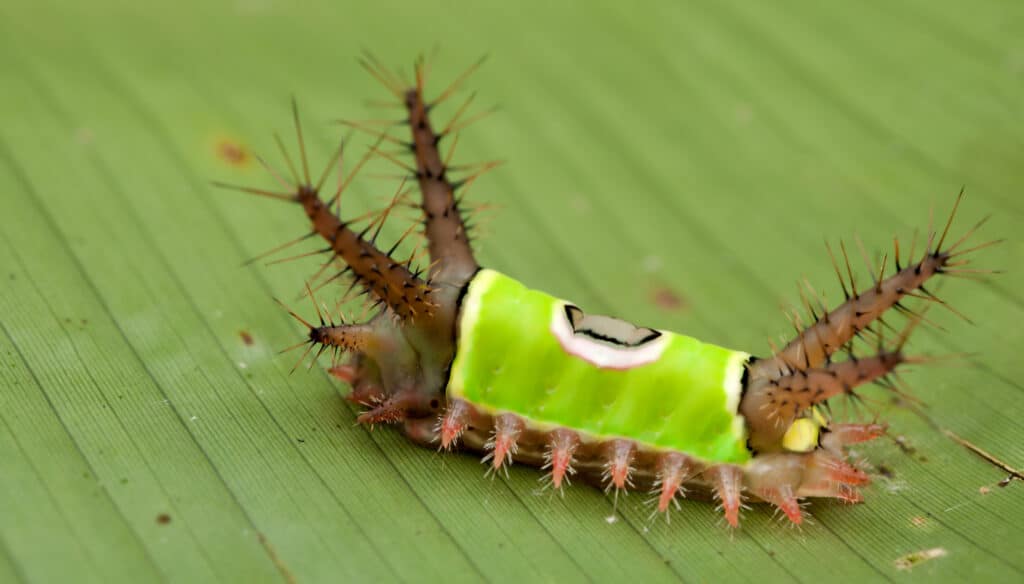
The saddleback caterpillar is native to North America and Mexico.
©Hagit Berkovich/Shutterstock.com
The saddleback caterpillar is a unique and visually striking creature. It’s most notable for its vibrant green coloration, punctuated by a prominent, saddle-like brown marking on its back, which gives it its distinctive name. Despite its beauty, however, the saddleback caterpillar is one of the most venomous caterpillars in North America. The bristle-like spines that adorn its body are not just for show — they can deliver a powerful sting that causes severe pain and even serious medical conditions in humans. Therefore, despite its attractive appearance, it’s crucial to approach the saddleback caterpillar with caution or avoid it entirely.
14. Io Moth Caterpillar (Automeris io)
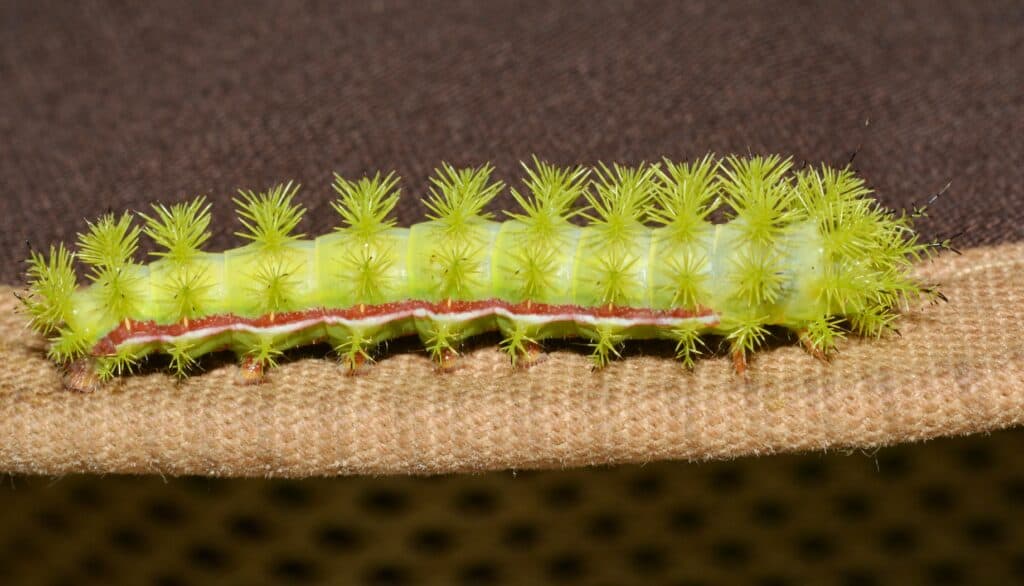
Io moth caterpillars have dense, prickly spines that can cause severe irritation upon contact.
©Andy Reago & Chrissy McClarren / CC BY 2.0 – License
Behold the captivating Io moth caterpillar, an intriguing indigenous species of North America! Its verdant physique, adorned with striking red and white stripes, conceals a perilous secret — bristly spines capable of inflicting a painful sting. With an insatiable appetite, this caterpillar voraciously consumes foliage, defoliating trees and shrubs with remarkable swiftness. However, after a month of nourishment, a metamorphosis occurs, unveiling a resplendent adult moth. One can only marvel at its vibrant orange wings, adorned with exquisite eyespots.
15. Spiny Oakworm Caterpillar (Anisota spinifera)
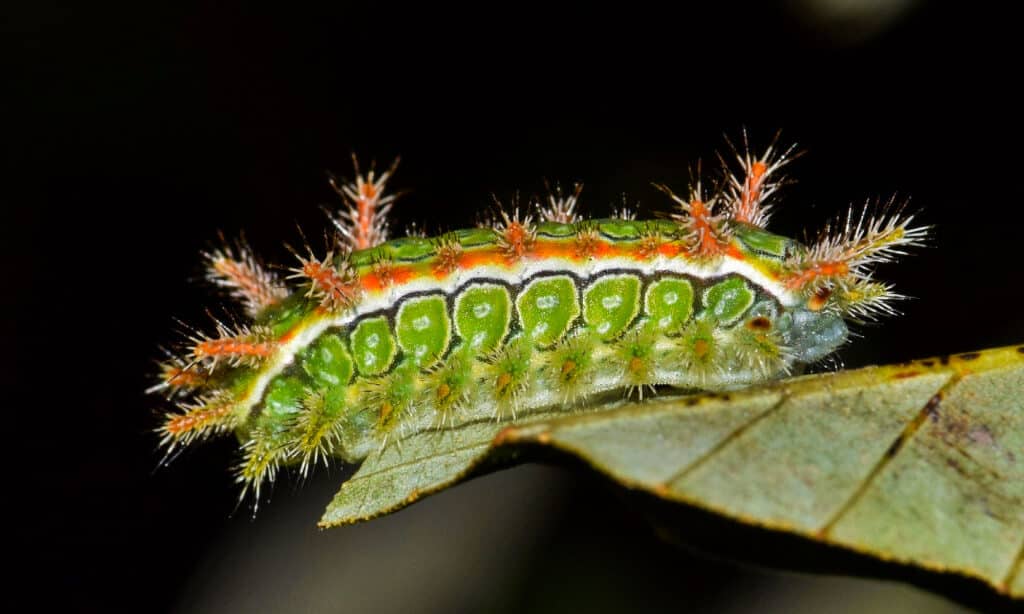
Spiny oakworm caterpillars typically live in wooded areas of New Jersey.
©iStock.com/Brett_Hondow
The spiny oakworm caterpillar is an intriguing creature commonly encountered in North America. Renowned for its vibrant yellow and orange hues, it possesses a distinct appearance. Notably, this caterpillar boasts two pairs of long, black, spiny horns. As its name implies, the primary diet of the spiny oakworm caterpillar consists of oak leaves. The life cycle of this captivating organism is truly remarkable, commencing from a minuscule egg and undergoing a metamorphosis into a resplendent moth within a matter of weeks. Despite its formidable appearance, its spines are not venomous. However, they can cause irritation and rashes if touched.
16. Variegated Fritillary Caterpillar (Euptoieta claudia)

During the larval stage, fritillary caterpillars mostly feed on the leaves of violets.
©Stephan Morris/Shutterstock.com
This exquisite caterpillar lives in New Jersey and various regions of North America. When it reaches its complete growth, it measures approximately 1 to 1.5 inches in length. This splendid creature possesses a black body adorned with striking orange and white stripes, adorned further with black branched spines extending from each segment of its body. The variegated fritillary caterpillar, with its dietary preference for pansies, violets, and passionflowers, is often spotted in open fields, farmland, prairies, and roadsides. As it feasts on these plants, it unknowingly accumulates toxic chemicals within its body. This strategic defense mechanism makes the caterpillar unappetizing and potentially harmful to its predators, showcasing the marvels of nature’s intricate web.
Moth Caterpillars in New Jersey
| Common Names | Scientific Names |
|---|---|
| Cecropia Moth Caterpillar | Hyalophora cecropia |
| Luna Moth Caterpillar | Actias luna |
| Polyphemus Moth Caterpillar | Antheraea polyphemus |
| Large Maple Spanworm Caterpillar | Prochoerodes lineola |
| Curve-Lined Owlet Caterpillar | Phyprosopus callitrichoides |
| Wooly Bear Caterpillar | Pyrrharctia isabella |
Butterfly Caterpillars in New Jersey
| Common Name | Scientific Name |
|---|---|
| Black Swallowtail Caterpillar | Papilio polyxenes |
| Eastern Tiger Swallowtail Caterpillar | Papilio glaucus |
| Spicebush Swallowtail Caterpillar | Papilio troilus |
| Giant Swallowtail Caterpillar | Papilio cresphontes |
| Pipevine Swallowtail Caterpillar | Battus philenor |
Poisonous Caterpillars in New Jersey
| Common Name | Scientific Name |
|---|---|
| Puss Caterpillar | Megalopyge opercularis |
| Saddleback Caterpillar | Sibine stimulea |
| Io Moth Caterpillar | Automeris io |
| Spiny Oakworm Caterpillar | Anisota spinifera |
| Variegated Fritillary Caterpillar | Euptoieta claudia |
The photo featured at the top of this post is © Karel Bock/Shutterstock.com
Thank you for reading! Have some feedback for us? Contact the AZ Animals editorial team.




